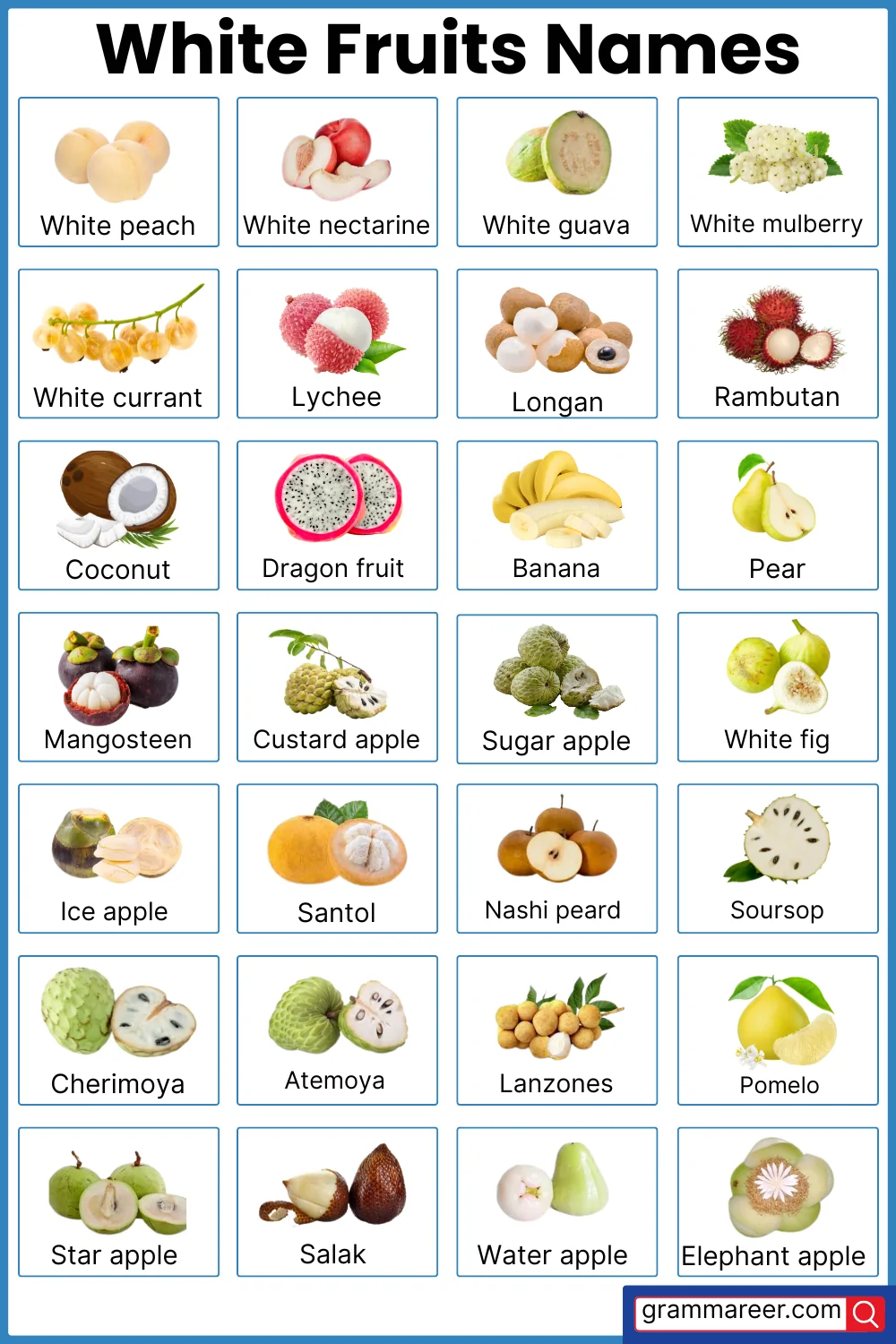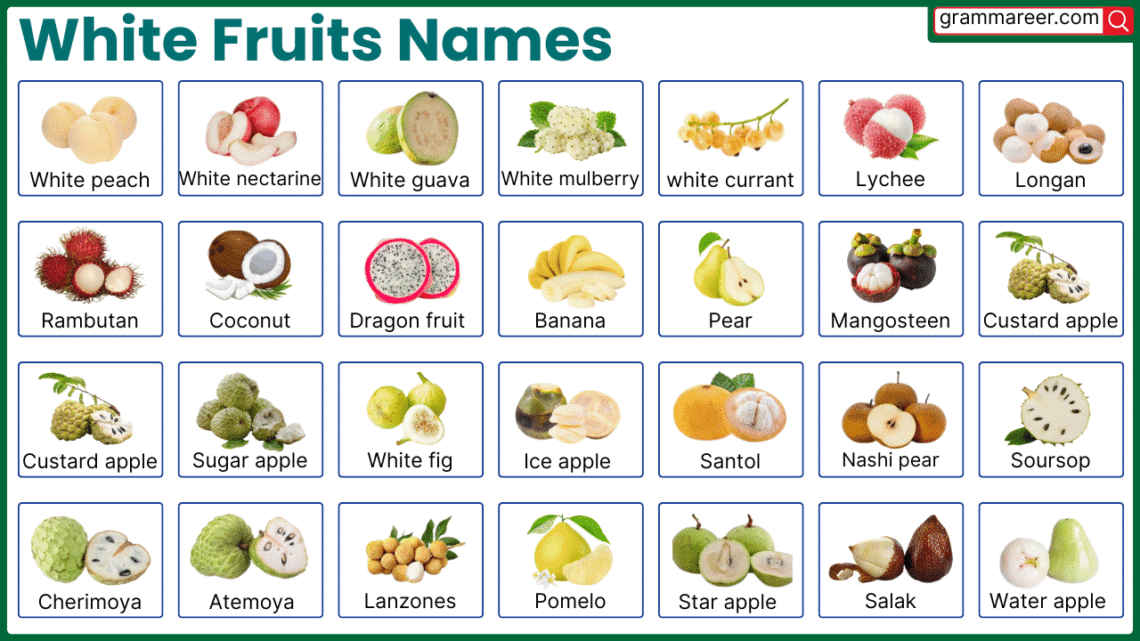Some fruits have a soft white color in their flesh or skin, making them stand out in nature. These include lychee, coconut, dragon fruit (white variety), white peach, and banana. While some are sweet and juicy, others are crisp or tender. These fruits can be found in tropical, temperate, or dry regions depending on the variety and season. Learning white fruits names with pictures makes it easier to tell them apart and remember their look and taste.
By learning white fruits names, you’ll build better food vocabulary and speak more clearly about fruit types in cooking, markets, health talks, or nature lessons.
Table of Contents
List of White Fruits Names with Pictures
- Banana
- Coconut
- Lychee
- Pear
- White Guava
- White Mulberry
- White Fig
- White Sapote
- Rambutan
- Longan
- White Currant
- White Dragon Fruit
- White Grapes
- Sugar Apple (White variety)
- White Peach
- White Nectarine
- White Cherry
- White Strawberry
- White Mango
- White Watermelon
- Soursop
- White Plum
- Custard Apple
- Ice Apple
- White Apple
- White Elderberry
- White Olive
- White Loquat
- White Star Apple
- White Pomegranate

White Fruits and Their Benefits in English
| White Fruit | Health Benefit |
|---|---|
| Banana | Improves digestion and heart health |
| Coconut | Hydrates body and boosts energy |
| Lychee | Rich in Vitamin C and antioxidants |
| White Guava | Supports immunity and skin health |
| White Mulberry | Regulates blood sugar and supports vision |
| White Fig | Improves bowel movement and bone strength |
| White Sapote | Helps with stress relief and digestion |
| White Pear | Boosts hydration and reduces inflammation |
| White Currant | Strengthens immunity and skin cells |
| Rambutan | Improves gut health and iron levels |
| Longan | Good for skin and memory |
| White Grapes | Support heart health and contain resveratrol |
| White Peach | Aids weight loss and digestion |
| White Cherry | Reduces inflammation and supports sleep |
| Ice Apple | Cools the body and hydrates |
| White Apple | Supports heart and brain health |
| White Mango | Boosts digestion and provides antioxidants |
| White Plum | Helps with constipation and liver function |
| Custard Apple | Strengthens immunity and supports eyes |
| White Dragon Fruit | Detoxifies the body and aids digestion |
50 White Fruits Names with Their Pictures
- Banana
- Coconut
- Lychee
- White Pear
- White Guava
- White Mulberry
- White Fig
- White Sapote
- Rambutan
- Longan
- White Currant
- White Dragon Fruit
- White Grapes
- White Peach
- White Nectarine
- White Cherry
- White Strawberry
- White Mango
- White Watermelon
- Soursop
- Sugar Apple
- Custard Apple
- Ice Apple
- White Apple
- White Elderberry
- White Olive
- White Loquat
- White Star Apple
- White Pomegranate
- White Banana (variety)
- White Kakadu Plum
- Santol (white pulp)
- Nance Fruit (white variety)
- White Mangosteen
- White Papaya
- White Raspberry
- White Tamarillo
- White Cactus Pear
- White Java Plum
- White Passion Fruit
- White Gooseberry
- Wax Apple (white)
- White Persimmon
- White Sapodilla
- White Blackberry
- White Tomato
- White Melon
- White Carambola
- White Duku
- White Noni Fruit
- White Indian Gooseberry

White Fruits Names with Descriptions
- Atemoya: A creamy white fruit that tastes like a mix of pineapple and vanilla.
- Custard apple: It has soft, white flesh that feels like custard and tastes very sweet.
- Santol: A tropical fruit with juicy white pulp that can taste sweet or sour.
- Sugar apple: Made of creamy white segments, this fruit has a sugary, rich flavor.
- Nashi pear: A crunchy Asian pear with juicy, white inside and light sweetness.
- Dragon fruit: A cactus fruit with white pulp and tiny black seeds, slightly sweet.
- Banana: Soft white flesh inside a yellow peel, sweet and filling.
- Lanzones: Small round fruits with translucent white flesh, juicy and sweet-sour.
- Water apple: Bell-shaped and crisp with mild white flesh, very refreshing.
- Salak: Known as snake fruit, it has pale flesh with a mix of sweet and tangy taste.
- Lychee: Juicy and sweet, with white translucent pulp inside a rough red peel.
- Longan: Round and juicy fruit with white flesh that tastes lightly sweet.
- White currant: A translucent white berry that tastes both sweet and a little tart.
- White fig: Light-skinned fig with soft white inside and honey-like sweetness.
- Soursop: A spiky green fruit with fibrous white flesh and a strong tangy-sweet flavor.
- Pear: Off-white flesh that is soft, juicy, and mild in sweetness.
- Pomelo: Large citrus fruit with pale juicy segments and a soft tangy flavor.
- Coconut: Hard shell with edible white meat inside, often used in food and drinks.
- Mangosteen: Round fruit with soft white flesh and a sweet juicy flavor.
- Ice apple: Jelly-like white fruit that cools the body, also called toddy palm fruit.
- Cherimoya: Green outside, creamy white flesh inside that tastes like banana and pineapple.
- Rambutan: Hairy fruit with juicy white flesh that is sweet and easy to eat.
- Star apple: A round fruit with soft white or clear flesh that tastes sweet and milky.
- Elephant apple: Has jelly-like white pulp with a tart, strong flavor.
- White peach: A peach with pale skin and white flesh that’s sweet and less acidic.
- White nectarine: Smooth fruit with white juicy flesh and a gentle sweetness.
- White guava: A pale guava with soft white inside and a mellow flavor.
- White mulberry: Soft white berry with mild sweetness and sometimes pale pink tint.
- White ackee: A rare ackee with white flesh; must be prepared carefully as parts are toxic.
- White jackfruit: Large fruit with white edible bulbs and sugary taste.
- White olive: A pale olive variety used in pickles or for making oil.
- Indian jujube: Small fruit with crisp white inside and gentle sweetness.
- White hog plum: Pale fruit with tart taste, often used in chutneys.
- Cactus pear: White inside with a mild flavor; grows on a cactus plant.
- White loquat: Has white flesh and a soft sweet flavor, rare in markets.
- White mangaba: A rare type of mangaba with white pulp and fruity scent.
- White gooseberry: Pale berry with sour to mildly sweet taste, used in sweets or pickles.
- Miracle fruit: Makes sour foods taste sweet after eating its white pulp.
- White tomato: Pale tomato with low acidity and creamy flesh.
- White persimmon: A light-fleshed persimmon with soft texture and a sweet pulp.
- White elderberry: A pale version used in syrup or wines for its light flavor.
- White carambola: Star-shaped fruit with pale flesh and tangy-sweet juice.
- White passionfruit: Rare passionfruit with white pulp and sweet, floral taste.
- White melon: Pale and juicy melon with soft texture and light sweetness.
- White pineapple: Very sweet pineapple with white flesh and no sharp acidity.
- White medlar: Rare medlar with mild pale flesh, not commonly found.
- White watermelon: Rare type of watermelon with white inside and mild crisp flavor.
- White strawberry: White strawberry with sweet taste like pineapple, looks unique.
- White grape: Pale grapes used in snacks or wine, soft and juicy.
- White cherry: Creamy-yellow to white cherry with sweet taste and soft bite.
- White sapote: Has white creamy flesh with custard-like sweetness, very smooth.
- White plum: Light-colored plum with juicy sweet white flesh.
- White apricot: Pale apricot with delicate sweetness and smooth soft bite.
FAQs about White Fruits
White fruits are fruits that are white in color from the inside or outside. They are often rich in fiber, potassium, and antioxidants.
Yes, white fruits provide numerous health benefits including improved digestion, heart health, and immunity.
Yes, banana is considered a white fruit because of its pale-colored flesh and starchy texture.
White guava, coconut, and lychee are excellent for skin health due to their Vitamin C and hydration properties.
Ten common white fruits include banana, coconut, lychee, white peach, white nectarine, white mulberry, Asian pear, rambutan, white-fleshed dragon fruit, and soursop.
You May Also Like




